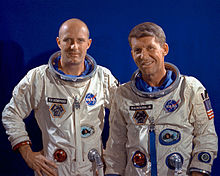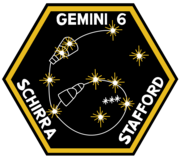Gemini 6

Gemini VI-A (foreground) and Gemini VII make the first rendezvous in orbit between two manned spacecraft
|
|
| Operator | NASA |
|---|---|
| COSPAR ID | 1965-104A |
| SATCAT no. | 1839 |
| Mission duration | 1 day, 1 hour, 51 minutes, 24 seconds |
| Distance travelled | 694,415 kilometers (374,954 nautical miles) |
| Orbits completed | 16 |
| Spacecraft properties | |
| Spacecraft | Gemini SC6 |
| Manufacturer | McDonnell. Phrase m |
| Launch mass | 3,546 kilograms (7,818 lb) |
| Crew | |
| Crew size | 2 |
| Members |
Walter M. Schirra, Jr. Thomas P. Stafford |
| Start of mission | |
| Launch date | December 15, 1965, 13:37:26 UTC |
| Rocket | Titan II GLV, s/n 62-12561 |
| Launch site | Cape Kennedy LC-19 |
| End of mission | |
| Recovered by | USS Wasp |
| Landing date | December 16, 1965, 15:28:50 UTC |
| Landing site | North Atlantic Ocean 23°35′N 67°50′W / 23.583°N 67.833°W |
| Orbital parameters | |
| Reference system | Geocentric |
| Regime | Low Earth orbit |
| Perigee | 270 kilometers (150 nautical miles) |
| Apogee | 274 kilometers (148 nautical miles) |
| Inclination | 28.9 degrees |
| Period | 89.95 minutes |
| Epoch | December 15, 1965 |
 (L-R) Stafford, Schirra |
|
Gemini 6A (officially Gemini VI-A) was a 1965 manned United States spaceflight in NASA's Gemini program. The mission achieved the first manned rendezvous with another spacecraft, its sister Gemini 7. Although the Soviet Union had twice previously launched simultaneous pairs of Vostok spacecraft, these established radio contact with, but came no closer than several kilometers of each other, while the Gemini 6 and 7 spacecraft came as close as one foot (30 cm) and could have docked had they been so equipped.
Gemini 6A was the fifth manned Gemini flight, the 13th manned American flight, and the 21st manned spaceflight of all time (including X-15 flights over 100 kilometers (54 nautical miles)).
This was the prime crew on Gemini 3
The original Gemini 6 mission, scheduled for launch on October 25, 1965 at 12:41 pm EDT, had a planned mission duration of 46 hours 47 minutes, completing a total of 29 orbits. It was to land in the western Atlantic Ocean south of Bermuda.
The mission was to include four dockings with the Agena Target Vehicle. The first docking was scheduled for five hours and forty minutes into the mission. The second was scheduled for seven hours and forty-five minutes, the third at nine hours and forty minutes, and the fourth and final docking at ten hours and five minutes into the mission. The final undocking would take place at 18 hours and 20 minutes into the mission. At 23 hours and 55 minutes into the mission, while the spacecraft passed over White Sands, New Mexico, the crew was to attempt to observe a laser beam originating from the ground. The retrorockets were scheduled to be fired at 46 hours and 10 minutes into the mission over the Pacific Ocean on the 29th orbit.
...
Wikipedia

